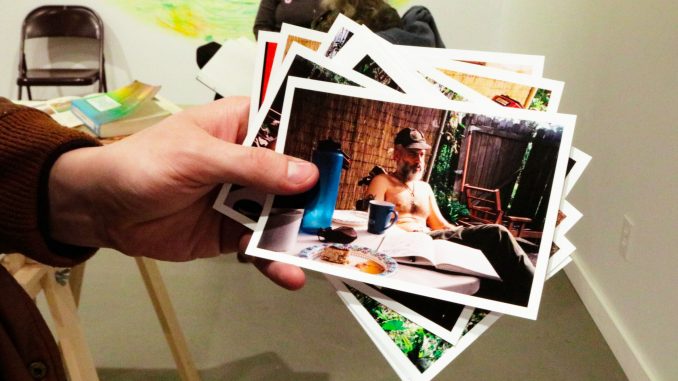
Grimaldi Baez was 6 years old when he moved from Puerto Rico to a predominately white, working-class neighborhood in Massachusetts with his family.
It was in this neighborhood where Baez, a 2015 master’s of printmaking alumnus, learned about racism. He said he was once sent to the principal’s office for speaking Spanish.
“This type of bigotry transcends pigment,” Baez said.
For Baez, the effects of bigotry seem more clear in the wake of hurricanes Irma and Maria, which hit Puerto Rico in August and September 2017.
With increased focus on the conditions of Puerto Rico in the media, Baez, Sheldon Abba, a 2013 advertising alumnus, and Ricky Yanas, a Philadelphia artist, all saw an opportunity to reveal the corruption they say has existed in Puerto Rico for years.
Focused on the themes of government and economic corruption, the artists are showing a series of murals, videos and photographs taken on film in “Extension or Communication: Puerto Rico” an exhibit at the Crane Arts Center on American Street near Master. The exhibit runs through Feb. 17.
President Donald Trump’s response to the storms in Puerto Rico was slower than his response to Hurricane Harvey, which hit Texas in August 2017. He visited Texas four days after the storm made landfall, but didn’t visit Puerto Rico until two weeks after Hurricane Maria.
Trump signed a relief bill that gave up to $4.9 billion in loans to help Puerto Rico’s government. But today, nearly 500,000 people are still without power on the island.
“It’s a colonial paradigm that we are looking at,” Baez said. “There have been many people throughout American history who have been marginalized, and who have been dominated by a hegemonic culture.”
Baez, Abba and Yanas traveled to Puerto Rico for 10 days in December 2017 to take photographs, gather artifacts and record video for the exhibit.
During their stay, the artists explored the urban communities of San Juan and the mountainous villages of rural Puerto Rico to investigate the living conditions of residents across the island.
The family they stayed with when they visited Puerto Rico had just received a tarp from the Federal Emergency Management Agency. It was used as a temporary roof for the family, Abba said.
The three artists tried to capture the struggles between Puerto Rican and American mainland powers in their exhibit.
Among the mix of images within the gallery was a photograph of a storm-beaten McDonalds in Puerto Rico next to a photograph of an abandoned sugarcane factory. This juxtaposition was in an effort to explore the effects American corporations have had on Puerto Rico.
“The…sugarcane factory used to be one of the largest on the island, but it hasn’t been running for a long time,” Abba said. “It is in complete disrepair, and even now there’s still an underground pool of black oil just sitting there.”
During their trip, Abba said the artists almost didn’t notice the factory when they drove by it. They first noticed a farmer and his son working on the land where the abandoned factory once stood.
“It was interesting to see that narrative, to see the resiliencies of these people…and to see how people organize themselves to manage with the issues they’re facing,” Abba said.
In an effort to move past the devastation of the hurricanes, Puerto Ricans have attempted to rebuild their communities through supportive action, cultivation of crops and construction efforts.
“If you go into San Juan, all the buildings are covered in a fresh layer of paint,” Abba said. “You’ll see the greenery of community gardens popping up, and new foliage appearing. But then you’ll see a shredded billboard, or one lamppost might be off.”
Puerto Rican residents continue to confront homelessness, poverty and food shortages months after the initial devastation.
Viewers of the exhibit have the opportunity to explore their relationship with the current state of Puerto Rico.
“Our goal here is to define some of the narratives that we gathered and then [attempt] to open them up in a way that other artists and individuals can identify with them, and expand upon,” Abba said.
Since October, Baez has raised nearly $14,000 to assist those in Puerto Rico through GoFundMe, a crowd-funding website. The funds will be used to purchase portable solar lights and water filters for those living without electricity and clean water sources.
He said this project is a way to reflect on his childhood.
“This whole project is a return for me,” Baez said. “It’s been something that has been with me for a long time.”


Be the first to comment